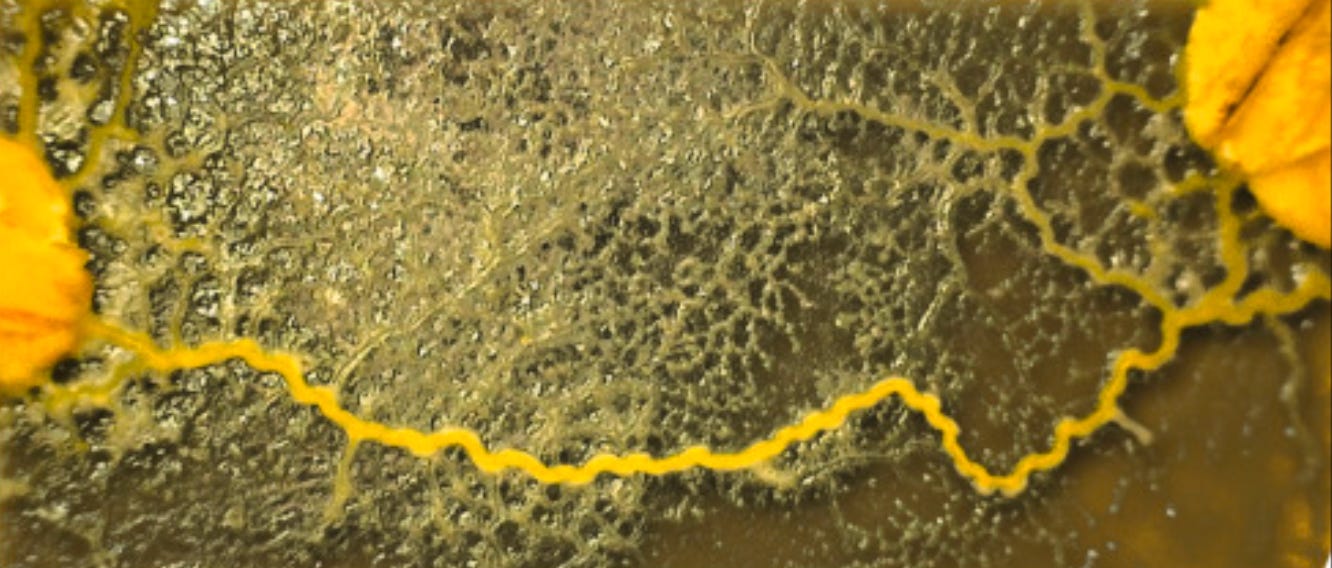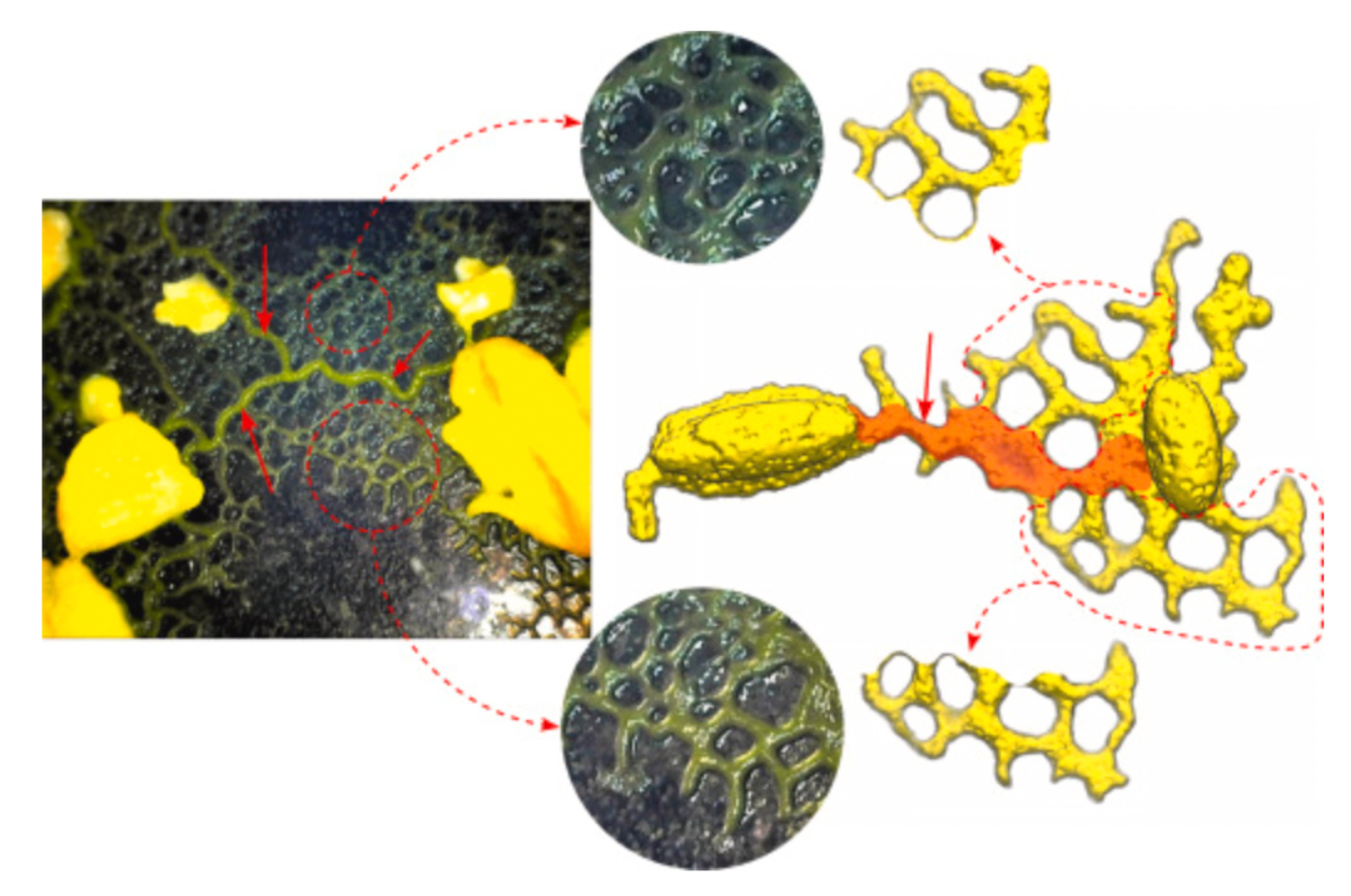Navigating complex environments without a brain
Recent study builds model to predict how slime molds function without centralized leadership
The slime mold Physarum polycephalum in its plasmodium form. Although they are single-celled organisms, slime molds can congregate with one another, moving about the environment together and forming macroscopic structures like this.
During its infancy, the study of evolution was often approached from a hierarchical perspective. Life originated with simple, primitive organisms, and the process of evolution gave rise to more advanced organisms. However, it is now well appreciated that the line between “simple” and “complex” in biology is more blurred than ever. Perhaps no organism blurs this line more than the slime mold. In a recent study, Dr. Farshad Ghanbari, a postdoctoral scholar at Penn State University, and colleagues built a mathematical model to better understand how these fascinating organisms can exhibit dynamic behavior without any central nervous system1.
Slime molds are a group of single-celled organisms once thought to be fungi, but they have since been classified separately. While slime molds can survive as individual cells, when food availability is low, they will form colonies, giving rise to a macroscopic structure called a “plasmodium”2. Interestingly, the plasmodium form is still a single-celled entity. Individual cells fuse into a single cell, but with multiple nuclei, allowing the slime mold to grow and acquire resources more efficiently.
“When they come together, slime molds exhibit this weird form of intelligence,” says Ghabari. “They can solve mazes, detect nutrients or toxins, and even store memories about different environmental conditions. In one famous study, slime molds formed networks that resembled the connections in the Tokyo subway system.”
Despite growing scientific interest in slime molds, it is still not well understood how they are able to move in complex environments. The challenge to modeling this movement is accounting for the multiple scales that slime molds operate. On one hand, there are thousands of small interactions between individual nuclei of the slime mold that need to be accounted for. Meanwhile, at the macroscopic level, there is the behavior of the entire collective to consider, for instance, the branching pattern seen in the image above. In his model, Ghanbari aimed to account for behavior at both of these scales.
When building a biological model, the aim is to create a mathematical equation which can predict the behavior of a biological system. How do you even start solving this problem? “I come from a mechanical engineering background. I try to dissect every system into its building blocks, starting with the physics and mechanical forces that are at play,” explains Ghanbari. “Slime molds are similar to many models in physics including the solidification of a material or the formation of ice crystals. We can also look at models of fungal growth, which have some similar properties to slime molds.”
Slime molds are also unique in that they are not really a solid or a liquid, and exist as a “goop” of sorts. Ultimately, Ghanbari chose to model slime mold's cytoplasm as a fluid, because the cytoplasm's movement inside the slime mold cell is most closely resembles a liquid. Then, he accounted for nutrient availability as an environmental stimulus that slime molds respond to. This included a feedback where places with nutrients or optimal environmental conditions form stronger connections, leading to thicker branches in the plasmodium.
Another key feature of movement that was modeled for the first time in this study was the “pulsation” behavior of slime molds' macroplasmodium. “As they grow and move, the slime mold has this inherent pulsation that allows it to efficiently distribute nutrients about the network,” describes Ghanbari. “The math behind this pulsation can also be taken from models of physics.”
Comparison between simulated slime mold network using model in the paper (right) and observed slime mold network (left). The model is able to accurately capture components of the observed network, for instance, the formation of thicker branches between nutrient sources (highlighted in red on the right).
The final step when building a biological model is assessing its predictive power by comparing simulations from the model to observed patterns. As outlined in the figure above, the model in this paper very strongly predicts the behavior of slime molds. This is quite notable, given the complexity of the slime mold system where behavior is the outcome of thousands of individual interactions. By taking a bottom-up approach, starting with the basic laws of mechanics and working its way up to complex interactions between the nuclei of slime molds, this study produced perhaps the most complete model of slime mold movement to date.
In the future, slime molds could be used a model for swam intelligence, as Ghanbari outlines: “We're trying to learn from the slime mold. We can extract simplistic rules of behavior based on the way that the slime mold behaves, and assign those rules to tiny robots called ‘kilobots’.” By training robots using the rules that slime molds follow, researchers will be able to better understand how intelligence can emerge from relatively simple components.
Ultimately, slime molds emphasize that we should not be too quick to associate complexity with intelligence. Although individual slime molds are not intelligent and lack any nervous system, they are still able to achieve incredible feats and efficiently solve problems when they work as a collective.
References
(1) Ghanbari, F, Sgarrella, J, Peco, C. Emergent dynamics in slime mold networks. Journal of the Mechanics and Physics of Solids. 2023.
(2) Baldauf, SL and Doolittle, WF. Origin and evolution of the slime molds (Mycetozoa). Evolution. 1997.
Image credits
All images borrowed from Ghanbari et al 2023.



